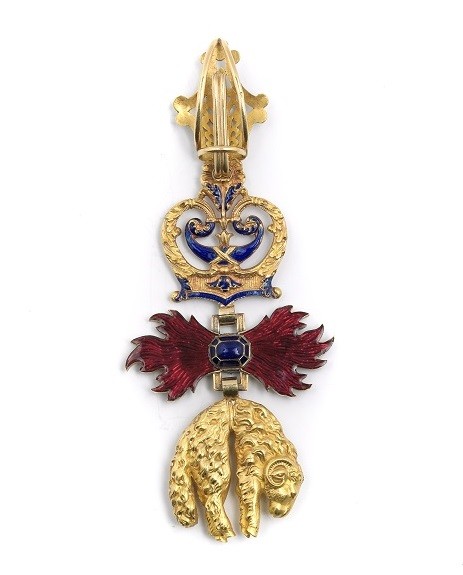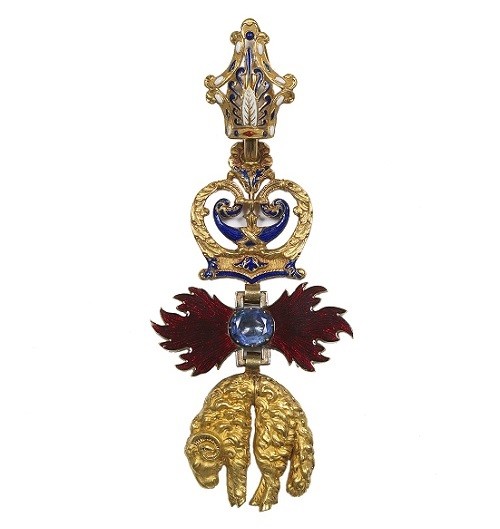Napoleon Eugène Louis Jean Joseph Bonaparte (1856-1879), Prince Imperial, was the recipient of a number of orders and decorations during his life, although these distinctions are often overshadowed by the large and impressive collection belonging to his father, the Emperor Napoleon III. Napoleon III’s collection is the only complete set of decorations belonging to a French sovereign in existence today. (The collection of orders and decorations belonging to Napoleon III, the Empress Eugenie and their son are part of the extraordinary donation made by the Prince and Princess Napoleon in 1979. This medal collection is now on display at the Napoleon III Museum in the Palais de Compiègne).
The young prince was in the public eye from a very young age, most notably as the honorary president of the Exposition Universelle of 1867 (when he was eleven years old), and in his short life (he died at the age of twenty three) he was awarded just under thirty decorations over a period of fourteen years. (The only decoration he received after the fall of the Second French Empire was the South Africa Medal (British) which was awarded posthumously in 1880.).
The first and most prestigious of these decorations was the Order of the Toison d’Or [or Golden Fleece], which he was awarded at birth. This medal, presented above, was acquired by the Musée National de la Légion d’Honneur et des Ordres de Chevalerie [The National Museum of the Legion of Honour and Orders of Chivalry] in 1932, and is now on display as part of the museum’s Second-Empire collection, which reopened in March 2020.
The Order of the Golden Fleece
The Order of the Golden Fleece is one of the oldest surviving orders of chivalry and was initiated by the Duke of Burgundy, Philippe le Bon [Phillip the Good] on 10 January 1430, on the occasion of his marriage to the Infanta Isabel of Portugal in Bruges.
Philip the Good, the “Premier Lay Peer of France”, reigned over vast territories including Burgundy and Franche-Comté, as well as areas in modern-day Belgium and the Netherlands. Although he was a vassal to the King of France, he was one of the most powerful princes in Europe.
The duke initiated this new order of chivalry to assert his dynastic power. He aimed to surround himself with a large, subservient group of lords. Under the influence of the early Renaissance and the rediscovery of classical antiquity, he chose the golden fleece as the symbol of his new order, in reference to the Greek myth of Jason and the Argonauts.
Upon receiving the order, each knight would receive a jewelled collar (the property of the order), made up of a series of firesteels in the shape of B (for Phillip the Good’s duchy of Burgundy) interspersed with flintstones setting off sparks, with the corpse of a ram suspended below. The Golden Fleece part of the collar was the property of the knight and was to be worn separately on a daily basis, suspended from a red ribbon.
Upon the marriage of Marie de Bourgogne – the last descendant of Philip the Good – and the Archduke Maximilian of Austria, the order passed into the hands of the House of Habsburg and linked to the Spanish crown as a result of the abdication of Charles V in 1555. The Golden Fleece was then divided when a Bourbon king, Philip of Anjou, came to the Spanish throne in 1700. Both the Spanish House of Bourbon and the Austrian Habsbourgs then claimed to have legitimate rights to the order.
There have been two Orders of the Golden Fleece ever since: the Austrian Order, which is now has its own legal identity and is under the sovereignty of the House of Habsburg-Lorraine (although no longer the reigning house) in accordance with the international law; and the Spanish Order, which is still the highest decoration bestowed by King Philip VI. Owing to the family ties between the sovereigns on either side of the Pyrenees, and nowadays for diplomatic reasons, French heads of state are generally awarded the Spanish Order of the Golden Fleece.
The Prince Imperial and the Order of the Golden Fleece
Born on 16 March 1856, the Prince Impérial was appointed knight of the Order of the Golden Fleece on 30 March 1856 by Queen Isabella II, when he was only fourteen days old. This was the third decoration received by Louis-Napoleon, after the Légion d’Honneur [the Legion of Honour] and the Médaille Militaire [Military Medal], awarded the day he was born, and the first of his twenty-eight foreign orders.
He was the 987th knight to be appointed to the order and the only knight appointed during the time of the Second French Empire (his father had been appointed during the Second French Republic).
As was reported in the Moniteur Universel, the Prince Imperial’s Golden Fleece Order collar was presented to his father on 13 April at the Tuileries Palace, by ‘His excellency, the Duc d’Albe, accompanied by Monsieur le Général Barcaitzegui, ADC to the King of Spain’ (Moniteur Universel, April 14, 1856, p. 413.).

The prince also received the insignia shown here, a typical example of the Golden Fleece insignia made in Spain after 1850.
The medal features the profile of a ram and a stylised firesteel. The flint stone is made of sapphire, and surrounded by two red enamelled flames. It is almost identical to that of Napoleon III (Napoleon III was appointed knight when he was Prince-President, on 17 September 1850. He was the 975th knight of the order), which is housed in the Palais de Compiègne (Inv. FPN 3893), with the rest of the imperial collection.
On 18 September, a few months after the prince’s death on 1 June 1879, his collar was sent back to Madrid by Empress Eugenie (It was later given to the Marquis of Bedmar, the Duke of Oporto and then to the King of Belgium, Leopold III (information kindly provided by A. de Ceballos-Escalera y Gila).).
A note kept in Louis-Napoleon’s medal box informs us that it was transported by Don Manuel Rances y Villanueva, Marquis of Casa Laiglesia, the Spanish ambassador to Great Britain. The medal remained the property of the knight and was kept in the Empress Eugenie’s collection at Farnborough Castle until the artefacts were dispersed in 1927 (7 years after the Empress’s death on 11 July 1920). Henri Torre, the first curator of the Musée de la Légion d’Honneur, facilitated its donation in 1932 (made by Mr Bagby) when the ‘foreign orders’ collection was being built up and put together.
It is still on display in a new exhibition dedicated to the Empress Eugenie and the Prince Imperial.
Tom Dutheil, Assistant Curator of the Musée de la Légion d’Honneur, March 2020. (translation JR)
Bibliography
- Anne de Chefdebien (dir.) and Laurence Wodey (dir.), Écrins impériaux : Splendeurs diplomatiques du Second Empire, Société des amis du musée national de la Légion d’honneur et des ordres de chevalerie [Imperial Decorations: Diplomatic splendours of the Second Empire, Society of Friends of the Musée National de la Légion d’Honneur et des Ordres de Chevalerie], 2011. Exhibition catalogue from the Musée de la Légion d’Honneur’s exhibition held 19 January to 29 May 2011.
- Alfonso Ceballos-Escalera y Gila, La insigne órden del Toisón de Oro, Patrimonio Nacional, 1996.
- Claude Ducourtial-Rey, Napoléon III raconté par les décorations, Musée National de la Légion d’Honneur et des Ordres de Chevalerie, Paris, 1973, Exhibition Catalogue from the Musée de la Légion d’Honneur’s exhibition held from 28 November 1973 to 27 January 1974.
- Jean-Claude Lachnitt : Le Prince impérial. Napoléon IV, Perrin, Paris, 1998.


